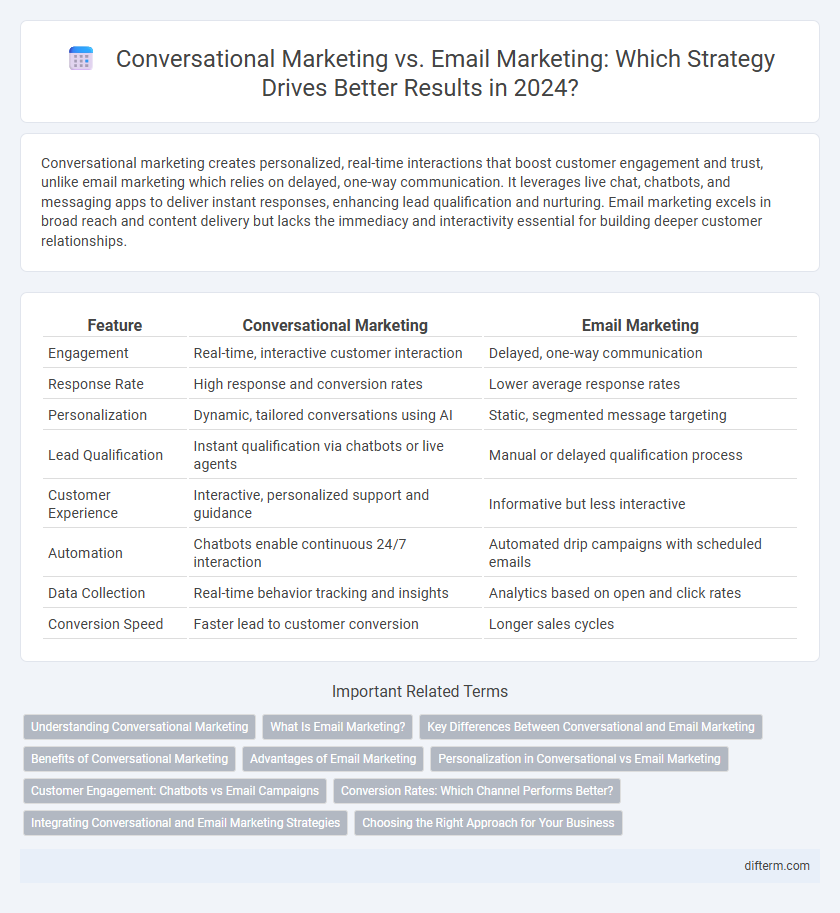Conversational marketing creates personalized, real-time interactions that boost customer engagement and trust, unlike email marketing which relies on delayed, one-way communication. It leverages live chat, chatbots, and messaging apps to deliver instant responses, enhancing lead qualification and nurturing. Email marketing excels in broad reach and content delivery but lacks the immediacy and interactivity essential for building deeper customer relationships.
Table of Comparison
| Feature | Conversational Marketing | Email Marketing |
|---|---|---|
| Engagement | Real-time, interactive customer interaction | Delayed, one-way communication |
| Response Rate | High response and conversion rates | Lower average response rates |
| Personalization | Dynamic, tailored conversations using AI | Static, segmented message targeting |
| Lead Qualification | Instant qualification via chatbots or live agents | Manual or delayed qualification process |
| Customer Experience | Interactive, personalized support and guidance | Informative but less interactive |
| Automation | Chatbots enable continuous 24/7 interaction | Automated drip campaigns with scheduled emails |
| Data Collection | Real-time behavior tracking and insights | Analytics based on open and click rates |
| Conversion Speed | Faster lead to customer conversion | Longer sales cycles |
Understanding Conversational Marketing
Conversational marketing leverages real-time, personalized interactions through chatbots and messaging apps to engage customers directly, fostering immediate responses and building stronger relationships. Unlike email marketing's one-way communication, conversational marketing creates dynamic dialogues that enhance customer experience and increase conversion rates. This strategy utilizes AI-driven insights to tailor conversations, making it highly effective for lead qualification and boosting sales performance.
What Is Email Marketing?
Email marketing is a digital marketing strategy that uses targeted email campaigns to engage customers, promote products, and nurture leads. It leverages personalized messages, automation tools, and analytics to deliver relevant content directly to subscribers' inboxes. This method enhances customer retention, boosts conversion rates, and complements broader marketing efforts by fostering direct communication.
Key Differences Between Conversational and Email Marketing
Conversational marketing prioritizes real-time, personalized interactions through chatbots or messaging apps to engage customers instantly, while email marketing relies on scheduled, one-way messages targeting a broader audience. Conversational marketing drives higher engagement rates by enabling immediate responses and tailored experiences, whereas email marketing offers scalability and automation for long-term relationship building. The choice between these approaches hinges on whether a brand values direct, interactive communication or mass outreach with strategic content delivery.
Benefits of Conversational Marketing
Conversational marketing delivers real-time engagement by enabling personalized interactions through live chat, chatbots, and messaging apps, increasing customer satisfaction and conversion rates. This approach offers immediate feedback and dynamic dialogue, leading to faster lead qualification and nurturing compared to email marketing's delayed response times. Enhanced user experience and higher response rates make conversational marketing a powerful tool for building trust and driving sales growth in competitive markets.
Advantages of Email Marketing
Email marketing offers a direct, personalized communication channel with a high return on investment, boasting an average ROI of $42 for every dollar spent. It enables targeted segmentation, allowing marketers to deliver tailored content based on user behaviors and preferences, boosting engagement and conversion rates. Automated email campaigns streamline customer nurturing and retention, making it a cost-effective strategy for long-term relationship building.
Personalization in Conversational vs Email Marketing
Conversational marketing leverages real-time interactions to deliver highly personalized experiences by adapting messages based on immediate customer responses and behavior, increasing engagement and conversion rates. Email marketing relies on segmenting lists and using automated personalization tokens to tailor messages but often lacks the dynamic adaptability seen in conversational platforms. The key advantage of conversational marketing lies in its ability to create two-way personalization that evolves during customer interaction, providing a more relevant and timely experience compared to traditional email campaigns.
Customer Engagement: Chatbots vs Email Campaigns
Conversational marketing leverages chatbots to deliver real-time, personalized interactions that boost immediate customer engagement and satisfaction. Email marketing relies on targeted campaigns to nurture leads over time but often experiences lower open and response rates compared to chatbot conversations. Studies show chatbot-driven interactions increase engagement by up to 60%, making them effective for prompt customer support and conversion.
Conversion Rates: Which Channel Performs Better?
Conversational marketing drives higher conversion rates by enabling real-time, personalized interactions that address customer needs instantly, resulting in increased engagement and quicker decision-making. Email marketing, while effective for nurturing leads with targeted content, often suffers from lower open and click-through rates due to inbox saturation and delayed response times. Businesses leveraging chatbots, live chat, and messaging apps see conversion rates improve by up to 30% compared to traditional email campaigns, highlighting the growing preference for immediate, interactive communication channels.
Integrating Conversational and Email Marketing Strategies
Integrating conversational marketing with email marketing enhances customer engagement by combining real-time interaction with personalized follow-ups. Leveraging chatbots and live chat tools alongside targeted email campaigns creates a seamless customer journey that boosts conversion rates and retention. Data synchronization between both channels enables deeper audience insights, allowing marketers to tailor messages based on user behavior and preferences effectively.
Choosing the Right Approach for Your Business
Conversational marketing leverages real-time, personalized interactions through chatbots and messaging apps, boosting customer engagement and lead conversion rates. Email marketing remains a powerful tool for delivering targeted content and nurturing long-term customer relationships with measurable ROI. Aligning your choice with your business goals, target audience behavior, and available resources ensures optimal marketing performance.
Conversational marketing vs email marketing Infographic

 difterm.com
difterm.com